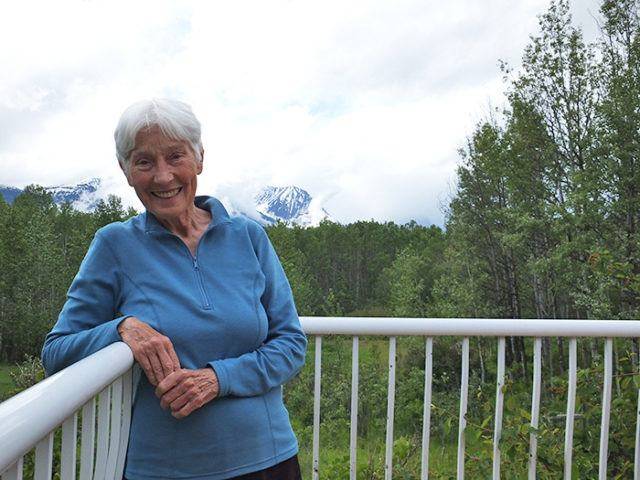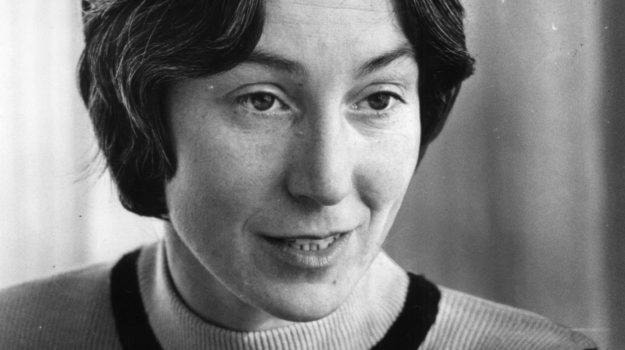If you have seen Mark Perry’s new video for his single “Who Am I,” there is a face in it you may not recognize, but perhaps should.
Kathleen Ruff was a pioneer in British Columbia’s and Canada’s human rights legal systems.
An anti-war activist, who came of age just following the Second World War in England, Ruff first came to public attention as a human rights activist in Canada as part of the women’s movement in a Vancouver Island group called Voice of Women. She later became the president of the Victoria Status of Women Action Group.
Following a failed attempt to get elected to the B.C. Legislature in 1972, the new NDP government called on Ruff to head up the newly formed Human Rights Branch of the Ministry of Labour after the B.C. Human Rights Code came into effect in 1974. She served in that capacity until 1978.
This history caught the attention of the national broadcaster and in 1979 she became host for the final season of the television program Ombudsman.
In 2016 her role in shutting down Canada’s asbestos industry earned her a medal of honour from the Quebec National Assembly.
WORKING CLASS
Kathleen Ruff, now 82, was born in the United Kingdom and grew up in the working-class London suburb of Richmond. Her mother was a domestic servant and her father was a bus conductor.
She credits the election of Britain’s Labour government following the Second World War with fostering the early values that guided her later activism.
She recalls the ration cards following the war, and how she and other children would get an extra third of a pint of milk to help build their strength.
“The government that got elected believed the working class were accepted to go die for the country, they should have a chance to live a decent life too,” she explained. “So, there was much more equality as a value.”
It was that same government that opened up opportunities for working-class people to go to university by providing grants to qualifying students.
Ruff wouldn’t get there right away, however, by virtue of her birthdate.
“You had to be 18 by the first day of the university year, which was September and I wasn’t 18 until December,” she explained.
She gave up on that prospect and did “what girls did” at the time, took a typing course and got a job, which she found boring and didn’t pay very well. Still, she accepted it as her lot in life.
“If you don’t see possibilities and opportunities, if you’ve never seen them, you’re unlikely to have them and I had never seen a man or woman study before,” she said. “My mom cleaned houses, so I did languages when I went to the grammar school because that’s what girls did. Going to university seemed like going to Mars.”
But during that time, she discovered there were opportunities for British girls to do au pair work overseas. She ended up working for a family in France.
On her one afternoon off each week she enrolled in classes for foreign students at the local university. It was there she encountered a male student from England who encouraged her to pursue a university education. Being over 18, she now qualified, applied and got the grant. She graduated with a degree in French.
While studying she met Norman Ruff, who was a year ahead of her. When he graduated, he migrated to Canada to pursue a masters degree in Montreal. She followed a year later and they married.
They eventually moved to New Brunswick where Norman had obtained a job with the provincial government. Despite her own university education, Kathleen worked as a shorthand typist.
“If we want a decent society where people all thrive and have a chance we’ve got to realize if people haven’t had any opportunities they’re not going to think of them so we’ve got to make sure they’re aware of them.
Again, by happenstance, it was another person who pushed Kathleen to pursue the opportunities now available to her. She went back to school and became a teacher.
“It so happened that I was in Frederickton and there was a teacher’s college there and they needed someone to teach English as a second language to Acadian students and teach them how to teach English as second language because they were going to go out into the world in schools.”
BUDDING ACTIVISM
It was through her association with the Acadian students that she started to recognize the ongoing systemic discrimination present in Canadian society.
“I always felt a bit of an outsider, I guess, because most of the people around me at university and everywhere had grown up fairly affluent, so I guess I felt a bit of an outsider, but that’s not necessarily a bad thing because then you see things that otherwise maybe you wouldn’t,” she said.
Norman’s career would take them back to Montreal for a stint, during which Kathleen taught English as a second language and finally to Victoria where Norman became was a professor of political science.
It was the 1960s, and along the way, Kathleen had started getting involved in activism as part of the peace movement in Montreal and later with the plight of immigrant farmers in B.C.
She was working on anti-racism issues when a Vancouver Island trade unionist pointed her in the direction of the women’s movement.
“He kind of opened my eyes because I hadn’t really thought very much about discrimination against women and I got involved.”
When the Royal Commission Report on the Status of Women in Canada was tabled in Parliament in 1970 and the B.C. government refused to recognize it applied to the province.
“So we documented from government’s own statistics massive discrimination against women in every possible field you can think of,” she recalled.
That got the Victoria Status of Women Action Group a lot of attention and people started bringing their complaints to Kathleen and she helped them.
“It’s always the people who have no power, politically, economic, any power, social status, that are treated unjustly, so they don’t have a prayer unless you can get it out in the open and you hope there’s enough people out in the public who say, ‘well, that’s not fair,’ and that’s how you can bring about change.”
CHANGE MAKER
And bring about change Kathleen has done.
As the first director of the B.C. Human Rights Branch (now B.C. Human Rights Commission), she refused to bend to political pressure aggressively advancing the human rights agenda in the early years of the legislation.
She recalled a particular case in which a women’s curling team in Langley complained about discrimination and the deputy minister tried to shut down the investigation.
“I said, no, the law says if there’s discrimination I shall investigate, I shall obey the law,” she said. “And so, we continued with it and we won the case.”
The investigations carried out by her investigators brought to light pervasive discrimination in B.C., particularly in employment.
BIG ASBESTOS
In 2007, Kathleen turned her attention to the asbestos industry.
During a decade of rallying the voices against Canada’s shameful promotion of Quebec asbestos exports and blocking the mineral’s inclusion on a list of dangerous substances under the Rotterdam Convention, Kathleen was vilified, harrassed and even received death threats.
One industry player even hired someone to spy on her.
“Over four years, he was pretending to be an ally and to be a documentary filmmaker,” she said. “What they were trying to do was, one, the more they knew about what our plan and strategy was, it made it easier for them to defeat it, but also, they had this belief because they were so corrupt themselves, that anybody like somebody like me would be genuinely working to end the asbestos industry unless I was being paid secretly by some industry that was in competition with the asbestos industry.”
It wasn’t just the industry itself that resisted. Federal politicians, eager to hang onto important Quebec votes dragged their feet on admitting to the terrible health and death toll asbestos has taken domestically and abroad.
Nevertheless, Kathleen carried on, writing dozens of papers, articles and engaging in international speaking tours herself, while lobbying others
Quebec finally stopped mining asbestos in 2012 and Kathleen was honoured by the Quebec National Assembly with its highest honour in 2016.
Kathleen bristles a bit at the personal public attention and credit she has garnered over the years, preferring to view the people who did come forward to advance the causes she has poured her passion into as the true heroes.
But others view her as the essential catalyst that made things happen.
When she was honoured by the Quebec legislature, the Montreal Gazette quoted her long-time collaborator on the asbestos issue.
“Kathleen Ruff is the true hero of this whole saga,” said Dr. Fernand Turcotte, a professor emeritus of public health and preventive medicine at the Université Laval.
Kathleen came to Smithers 18 years ago almost as a refuge.
“I love the outdoors and I love nature,” she said. “I’m in resistance to the world as it is and in the city it’s all smack in your face all these activities and values I don’t agree with.
“Here, it’s a small community, there’s lovely people here. There’s good and bad people here like there are everywhere, I’m not saying it’s perfect at all, but I’ve found a lot of kindness here and I’ve found people here that share my love of the outdoors.”
Now 82, she is slowing down a bit, but still finds time to advocate for and advance the cause of human rights through the organization Right On Canada, which she founded.

